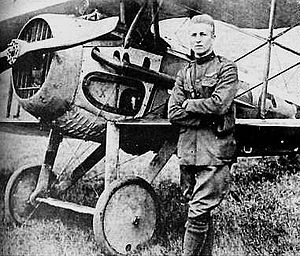| 27th Aero Squadron | |
|---|---|
 Lt. Frank Luke Jr. with his SPAD XIII at Rembercourt Airdrome, France, on 19 September 1918 | |
| Active | 15 June 1917 – 14 March 1921 |
| Country | |
| Branch | |
| Type | Squadron |
| Role | Pursuit |
| Part of | American Expeditionary Forces (AEF) |
| Fuselage Code | "American Eagle" |
| Engagements | World War I |
| Commanders | |
| Notable commanders | Maj. Harold E. Hartney Capt. Alfred S. Grant[1] |
| Insignia | |
| 27th Aero Squadron Emblem |  |
| Aircraft flown | |
| Fighter | Sopwith F-1 Camel, 1918 Nieuport 28, 1918 Spad XIII, 1918–1919[2] |
| Trainer | Curtiss JN-4, 1917–1918[2] |
| Service record | |
|---|---|
| Operations |
1st Pursuit Group Western Front, France: 29 May-11 November 1918[3] |
| Victories |
Air Aces: 6[5]
|
The 27th Aero Squadron was a United States Army Air Service unit that fought on the Western Front during World War I.
The squadron was assigned as a Day Pursuit (Fighter) Squadron as part of the 1st Pursuit Group, First United States Army. Its mission was to engage and clear enemy aircraft from the skies and provide escort to reconnaissance and bombardment squadrons over enemy territory. It also attacked enemy observation balloons, and perform close air support and tactical bombing attacks of enemy forces along the front lines.[1]
After the 1918 Armistice with Germany, the squadron returned to the United States in June 1919 and became part of the permanent United States Army Air Service in 1921, being re-designated as the 27th Squadron (Pursuit).[6][7]
The current United States Air Force unit which holds its lineage and history is the 27th Fighter Squadron, assigned to the 1st Operations Group, Joint Base Langley–Eustis, Virginia.[2]
- ^ a b c Over the Front: A Complete Record of the Fighter Aces and Units of the United States and French Air Services, 1914–1918 Norman Franks, Frank W. Bailey. Grub Street, 1992. ISBN 0- 948817-54-2, ISBN 978-0-948817-54-0.
- ^ a b c 27 Fighter Squadron (ACC) AFHRA Lineage and History Archived 23 February 2012 at the Wayback Machine
- ^ Series "H", Section "O", Volume 29, Weekly Statistical Reports of Air Service Activities, October 1918 – May 1919. Gorrell's History of the American Expeditionary Forces Air Service, 1917–1919, National Archives, Washington, D.C.
- ^ a b c Gorrell's History of the American Expeditionary Forces Air Service, Series M, Volume 38, Compilation of Confirmed Victories and Losses of the AEF Air Service as of 26 May 1919
- ^ 27th Aero [email protected]
- ^ Series "E", Volume 6, History of the 25th–27th Aero Squadrons. Gorrell's History of the American Expeditionary Forces Air Service, 1917–1919, National Archives, Washington, D.C.
- ^ Order of Battle of the United States Land Forces in the First World War, Volume 3, Part 3, Center of Military History, United States Army, 1949 (1988 Reprint)